Nature Diary Rocks History Gallery Links Home Page 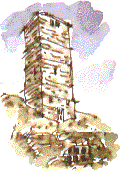 ON THE SLOPE below Heath village stands Dame Mary Bolles's Water Tower, dating from the 1600s. It was built over a hillside spring. Some of the spring water was used to turn a water wheel, which pumped a supply to Old Heath Hall, now in ruins, on the hill above.
ON THE SLOPE below Heath village stands Dame Mary Bolles's Water Tower, dating from the 1600s. It was built over a hillside spring. Some of the spring water was used to turn a water wheel, which pumped a supply to Old Heath Hall, now in ruins, on the hill above.
Fly Ash LagoonsWe walk on the permissive footpath alongside what were settling lagoons by the river, where pulverised fuel ash, a fine powdery waste, was pumped along a pipeline from the local power station and left to settle out. The power station was demolished and the cooling towers blown up about ten years ago. During the last 30 or 40 years the ashy soil of the dried out lagoons has been colonised by grasses and orchids. In the natural course of succession these are increasingly shaded out by scrubby birch and oak woodland. I've heard one ecologist suggest that if we wish to see such orchid-rich meadows in the future we need to create ash lagoons today. a fine powdery waste, was pumped along a pipeline from the local power station and left to settle out. The power station was demolished and the cooling towers blown up about ten years ago. During the last 30 or 40 years the ashy soil of the dried out lagoons has been colonised by grasses and orchids. In the natural course of succession these are increasingly shaded out by scrubby birch and oak woodland. I've heard one ecologist suggest that if we wish to see such orchid-rich meadows in the future we need to create ash lagoons today.
Not far from the boathouse I notice the ruins of a circular stone structure, about 12 feet in diameter, which I guess might be the remains of a summerhouse.
Kirkthorpe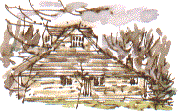 With its Almshouses, its stocks (designed to seat two) and a perfect country church, the village of Kirkthorpe seems remote and rural. It's hard to believe that we are only a kilometre from the outskirts of the city, just across the river.
With its Almshouses, its stocks (designed to seat two) and a perfect country church, the village of Kirkthorpe seems remote and rural. It's hard to believe that we are only a kilometre from the outskirts of the city, just across the river.At the east end of the church, a row of plain headstones mark the graves of Benedictine nuns who fled the French Revolution to live in exile at Heath Old Hall between 1811 and 1821. The inscriptions give only initials and dates but one records a name, perhaps she had yet to take her vows;
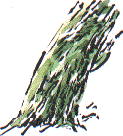
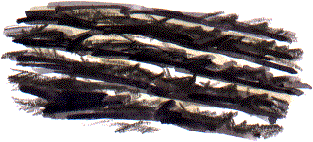 Crack Willows grow near the Half Moon at Kirkthorpe. As we walk along a green lane away from the village I notice that the dark ploughed slope alongside has the same roughly slashed pattern as willow bark.
Crack Willows grow near the Half Moon at Kirkthorpe. As we walk along a green lane away from the village I notice that the dark ploughed slope alongside has the same roughly slashed pattern as willow bark.
You'll find directions for this walk in my Village Walks in West Yorkshire, published by Countryside Books, price £6.95 (ISBN 1-85306-541-2).
|

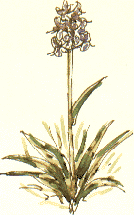 Dame Mary was said to have dabbled in witchcraft. She asked that the room where she died (in 1662) in the old hall should be sealed. When it was unsealed, 50 years later, it is claimed that her ghost appeared and proceeded to haunt the surrounding heath. I remember the 'haunted door' from the hall was once displayed at Wakefield Museum.
Dame Mary was said to have dabbled in witchcraft. She asked that the room where she died (in 1662) in the old hall should be sealed. When it was unsealed, 50 years later, it is claimed that her ghost appeared and proceeded to haunt the surrounding heath. I remember the 'haunted door' from the hall was once displayed at Wakefield Museum.
 We take a look at the old stone boathouse at the cut-off oxbow of the Calder known as the Half Moon. Spiny seed cases, now turned brownish, still lie beneath the Sweet Chestnuts in the woodland on the steep banking on the outer edge of the meander. Amongst the leaf litter the glossy green leaves of Bluebells are already showing.
We take a look at the old stone boathouse at the cut-off oxbow of the Calder known as the Half Moon. Spiny seed cases, now turned brownish, still lie beneath the Sweet Chestnuts in the woodland on the steep banking on the outer edge of the meander. Amongst the leaf litter the glossy green leaves of Bluebells are already showing.
 Back on one of the extensive village greens at Heath a flock of 25 Pied Wagtails are feeding.
Back on one of the extensive village greens at Heath a flock of 25 Pied Wagtails are feeding.